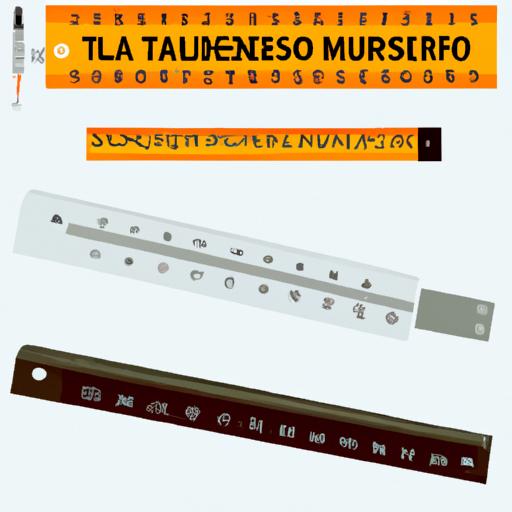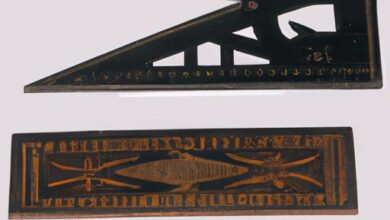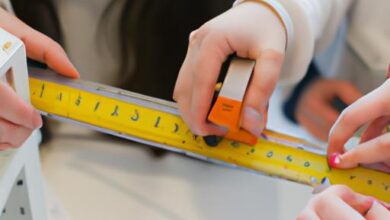What is Measuring Tools in Spanish?

Have you ever found yourself in a situation where you needed to understand the measurements in a different language, specifically Spanish? Whether you’re a professional in the manufacturing industry, a DIY enthusiast, or simply someone who wants to expand their knowledge, understanding measuring tools in Spanish can be incredibly valuable. In this article, we will explore the world of measuring tools, discuss their significance in different languages, and introduce you to the main keyword: “what is measuring tools in spanish.”
A Brief Explanation of Measuring Tools
Measuring tools are instruments used to determine the size, length, quantity, or degree of something. They are commonly utilized in various fields such as construction, engineering, carpentry, and science. From rulers and tape measures to calipers and thermometers, these tools play a crucial role in ensuring accurate measurements and precise outcomes.
The Importance of Understanding Measuring Tools in Different Languages
In today’s globalized world, where businesses are expanding their reach across borders, the ability to communicate effectively in multiple languages is essential. This holds particularly true for professionals who rely on measuring tools to carry out their work. Imagine being on a construction site or collaborating with Spanish-speaking colleagues or clients. The language barrier could hinder your efficiency and accuracy. Therefore, understanding measuring tools in different languages, including Spanish, becomes increasingly vital.
Introduction to the Main Keyword: “What is Measuring Tools in Spanish”
The main keyword of this article, “what is measuring tools in Spanish,” captures the essence of our discussion. We will delve into the translations of common measuring tools in Spanish, providing you with the necessary vocabulary to navigate the world of measurements in this widely spoken language. By the end of this article, you’ll not only have a better understanding of measuring tools but also be equipped with the knowledge to communicate effectively in Spanish-speaking environments.
So, are you ready to embark on this linguistic journey and unravel the world of measuring tools in Spanish? Let’s dive in and explore the translations that will empower you to bridge the language gap and enhance your professional and personal growth.
Measuring Tools: Definition and Types
Definition of Measuring Tools
Before we delve into the various types of measuring tools, let’s start by understanding what exactly measuring tools are. Measuring tools are instruments designed to quantify or assess the size, length, quantity, or degree of an object or substance. They provide accurate and precise measurements, enabling professionals in different industries to ensure quality, efficiency, and consistency in their work.
Overview of Different Types of Measuring Tools
Now that we have a clear understanding of the purpose of measuring tools, let’s explore the diverse range of tools available for different measurement needs. Here are some commonly used measuring tools:
1. Rulers and Tape Measures
Rulers and tape measures are fundamental measuring tools used to determine linear distances. They come in various lengths and units of measurement, such as inches, centimeters, or meters. Whether you’re measuring the length of a piece of fabric or marking dimensions on a construction site, rulers and tape measures are indispensable tools.
2. Calipers and Micrometers
Calipers and micrometers are precision measuring tools used to measure small distances with utmost accuracy. Calipers are typically used for larger measurements, while micrometers excel in measuring extremely fine details. These tools are commonly used in engineering, manufacturing, and scientific research.
3. Protractors and Angle Finders
Protractors and angle finders are tools designed to measure angles. They are essential for tasks that involve measuring, drawing, or cutting angles accurately. Protractors are commonly used in geometry, while angle finders are favored by carpenters, masons, and other professionals who work with angles in their daily tasks.
4. Thermometers and Hydrometers
Thermometers and hydrometers are measuring tools used to assess temperature and density, respectively. Thermometers are commonly used in fields such as healthcare, meteorology, and cooking, while hydrometers find applications in industries like brewing, winemaking, and chemical analysis.
5. Leveling Tools
Leveling tools, such as spirit levels or laser levels, are used to determine if a surface or object is perfectly horizontal or vertical. These tools are vital in construction, carpentry, and other trades that require precise alignment and leveling.
6. Measuring Gauges
Measuring gauges are specialized tools used to ensure accuracy in specific measurements. They can include thickness gauges, thread gauges, pressure gauges, and more. These tools serve industries such as automotive, manufacturing, and quality control.
By familiarizing yourself with these different types of measuring tools, you’ll be equipped with the knowledge to select the appropriate tool for your specific measurement needs. So, let’s continue our exploration and discover the translations of these measuring tools in Spanish in the following sections.
The Significance of Measuring Tools in Spanish
A. Expansion of Global Markets and the Need for Multilingual Understanding
In today’s interconnected world, global markets are expanding at a rapid pace. Businesses are venturing into new territories, reaching out to diverse audiences, and collaborating with partners from different linguistic backgrounds. This globalization has necessitated the need for professionals to possess multilingual skills, particularly in industries where accurate measurements are paramount.
Understanding measuring tools in Spanish becomes crucial when engaging with Spanish-speaking markets. By being able to communicate effectively in their language, you not only demonstrate respect for their culture but also establish a deeper connection. This linguistic bridge can open doors to new opportunities, facilitate smoother collaborations, and build trust with potential clients or partners.
B. Importance of Accurate Measurement in Various Industries
Accurate measurement is the foundation of success in numerous industries. Whether it’s construction, manufacturing, engineering, or any other field that relies on precise measurements, the consequences of inaccuracies can be costly and even dangerous. Imagine the impact of a miscalculated measurement on a construction project or the potential risks associated with imprecise engineering measurements.
By understanding measuring tools in Spanish, you ensure that language barriers do not hamper your ability to achieve accuracy. This proficiency allows you to interpret measurements correctly, follow instructions precisely, and deliver high-quality work. It enhances your professional reputation, boosts efficiency, and ultimately leads to improved outcomes in your respective industry.
C. Language Barriers and the Necessity to Understand Measuring Tools in Spanish
Language barriers can pose significant challenges, especially when it comes to technical fields like measurements. Miscommunication due to language differences can lead to misunderstandings, errors, and even safety hazards. This is why it is crucial to overcome these barriers by developing a comprehensive understanding of measuring tools in Spanish.
By investing time and effort into acquiring the necessary vocabulary and comprehension, you equip yourself with the ability to navigate conversations, read instructions, and collaborate effectively with Spanish-speaking colleagues or clients. Understanding measuring tools in Spanish not only enhances your professional competence but also demonstrates your adaptability and dedication to delivering accurate results.
In the next section, we will delve into the translations of common measuring tools in Spanish, providing you with the necessary knowledge to communicate and work seamlessly in Spanish-speaking environments. Let’s continue our journey of discovery and expand our language skills together!
Translations of Measuring Tools in Spanish
When it comes to understanding measuring tools in different languages, having a grasp of the translations is crucial. In this section, we will explore the Spanish translations of common measuring tools, enabling you to communicate effectively in Spanish-speaking environments. Let’s dive into the world of measurements in Spanish!
Common Measuring Tools and Their Spanish Translations
-
Ruler – Regla
The humble ruler, a staple in any toolbox or classroom, is called regla in Spanish. Whether you need to measure the length of an object or draw straight lines, having the translation at your fingertips will make your work smoother. -
Tape Measure – Cinta métrica
When it comes to measuring longer distances or circumferences, the tape measure is your go-to tool. In Spanish, it is called cinta métrica. Whether you’re renovating your home or undertaking a construction project, knowing this translation will come in handy. -
Caliper – Calibre
Calipers are precision tools used to measure the distance between two opposite sides of an object. In Spanish, they are referred to as calibre. Whether you’re a machinist, engineer, or involved in any field that requires precise measurements, understanding this translation is essential. -
Micrometer – Micrómetro
Micrometers are highly accurate measuring instruments used for precise measurements down to the micrometer level. In Spanish, they are called micrómetro. If you work in fields like mechanical engineering, machining, or quality control, knowing this translation is vital. -
Protractor – Transportador
Protractors are essential tools for measuring angles and drawing precise angles. In Spanish, a protractor is referred to as transportador. Whether you’re an architect, engineer, or math enthusiast, understanding this translation will help you accurately measure and construct angles. -
Thermometer – Termómetro
Thermometers are instruments used to measure temperature. In Spanish, they are called termómetro. Whether you’re monitoring the temperature in a scientific experiment, checking the weather, or measuring body temperature, knowing this translation is crucial. -
Hydrometer – Hidrómetro
Hydrometers are used to measure the specific gravity or density of liquids. In Spanish, they are known as hidrómetro. If you work in industries such as brewing, winemaking, or chemistry, understanding this translation is essential for accurate measurements. -
Level – Nivel
A level is an instrument used to determine whether a surface is horizontal or vertical. In Spanish, it is called nivel. Whether you’re hanging shelves, aligning tiles, or working in construction, knowing this translation will help you achieve precise alignment.
By familiarizing yourself with these translations, you’ll be well-equipped to navigate the world of measuring tools in Spanish-speaking environments. Enhance your communication, accuracy, and efficiency by incorporating these terms into your vocabulary.
Importance of Learning Measuring Tools in Spanish
Communication with Spanish-Speaking Colleagues or Clients
In today’s interconnected world, effective communication is key to success in any professional setting. By learning measuring tools in Spanish, you open up opportunities to collaborate seamlessly with Spanish-speaking colleagues or clients. Whether you’re working on a construction project, conducting scientific research, or involved in any industry that requires precise measurements, being able to communicate in your counterpart’s native language fosters better understanding and cooperation. It eliminates the chances of misinterpretation and ensures that everyone is on the same page when it comes to measurements, leading to smoother workflows and successful outcomes.
Enhanced Accuracy and Efficiency in Work
Accurate measurements are the foundation of any project or task that involves measuring tools. By learning the Spanish translations of measuring tools, you equip yourself with the knowledge to understand and interpret measurements accurately. This understanding directly impacts the quality of your work, ensuring that you achieve the desired precision and avoid costly errors. When you can comprehend the measurements in Spanish, you eliminate the need for constant translation or reliance on others for interpretation. This independence allows you to work more efficiently, saving time and resources.
Opportunities for Professional Growth and Market Expansion
In today’s competitive job market, possessing the ability to communicate and work effectively in multiple languages is a valuable asset. By learning measuring tools in Spanish, you demonstrate your commitment to professional growth and expand your marketability. Employers value employees who possess language skills as it opens doors to new markets and enhances the potential for business growth. Whether you’re seeking career advancement or exploring international opportunities, being proficient in Spanish and understanding measuring tools in the language can give you a competitive edge. It showcases your adaptability, cultural awareness, and willingness to go the extra mile in your professional endeavors.
So, why limit yourself to one language when you can gain a significant advantage by learning the Spanish translations of measuring tools? Embrace the opportunity to communicate effectively, improve your accuracy, and unlock new doors for professional growth and market expansion. By investing time and effort into learning measuring tools in Spanish, you position yourself as a versatile and competent professional ready to excel in any multilingual environment.
Conclusion
Understanding measuring tools in different languages, including Spanish, is crucial for professionals in various industries. In this article, we explored the significance of accurate measurements and the challenges posed by language barriers. We introduced the main keyword “what is measuring tools in Spanish” and provided translations for common measuring tools in Spanish.
By learning the Spanish translations for measuring tools, such as “regla” for ruler and “cinta métrica” for tape measure, you can effectively communicate with Spanish-speaking colleagues or clients, ensuring clear and precise measurements. This not only enhances your accuracy and efficiency but also opens up opportunities for professional growth and market expansion.
Remember, the ability to understand measuring tools in different languages is an invaluable skill in our globalized world. It allows you to navigate diverse work environments, collaborate effectively, and deliver precise results. So, take the initiative to learn and utilize the Spanish translations of measuring tools. By doing so, you’ll establish yourself as a knowledgeable and adaptable professional, ready to tackle any measurement challenge that comes your way.
Now that you have the tools to bridge the language gap, go forth and embrace the world of measuring tools in Spanish. Embrace the power of accurate communication and watch as your professional horizons expand. ¡Vamos y midamos con precisión en español! (Let’s measure accurately in Spanish!)
Keep exploring, keep measuring, and keep growing. The world of measurements awaits you!
Conclusion: So above is the What is Measuring Tools in Spanish? article. Hopefully with this article you can help you in life, always follow and read our good articles on the website: cook.mahjong-gratuit.net




